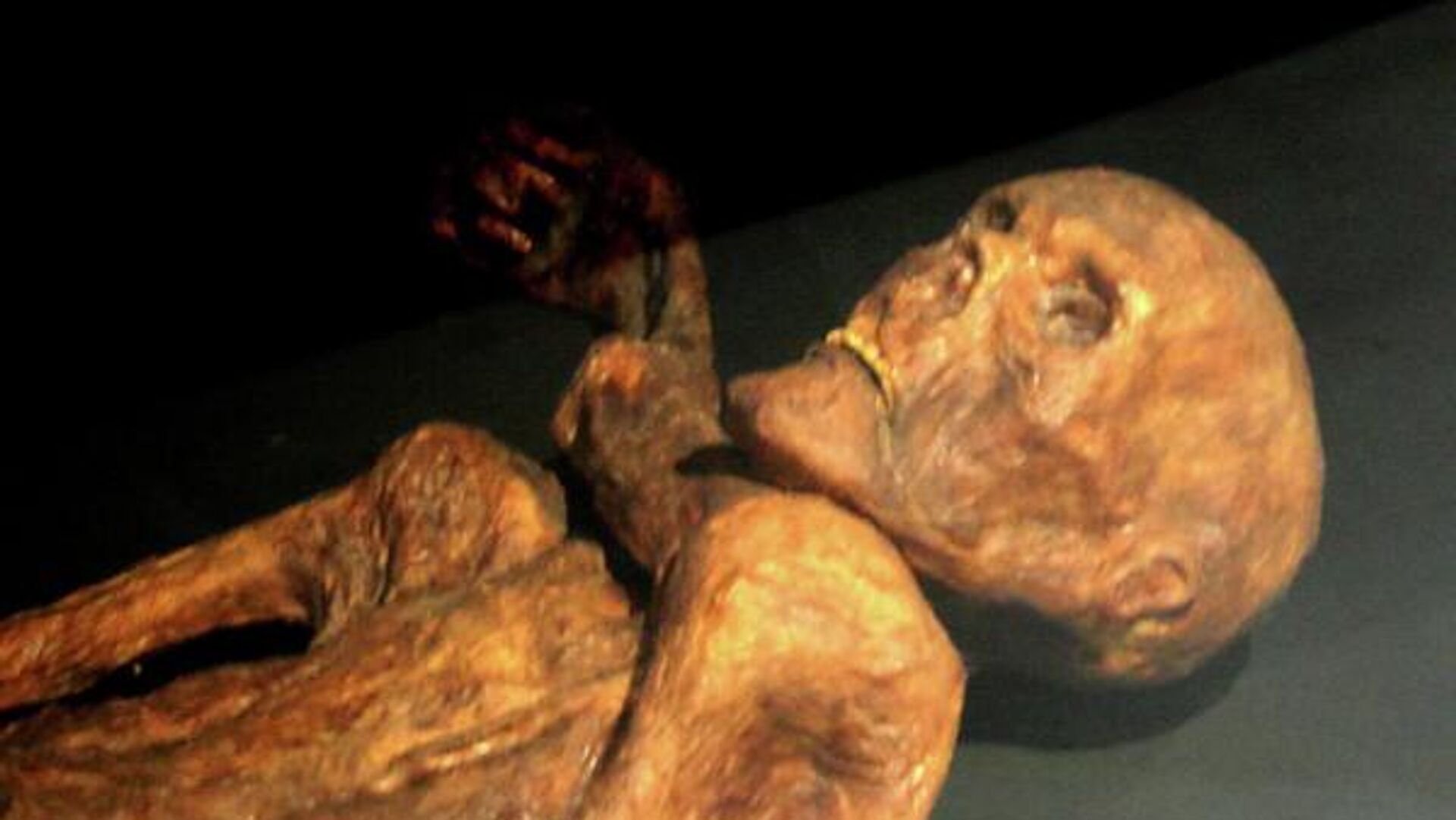https://sputnikglobe.com/20230816/tzi-the-icemans-true-appearance--ancestry-unveiled-by-dna-analysis-1112655655.html
Ötzi The Iceman's True Appearance & Ancestry Unveiled by DNA Analysis
Ötzi The Iceman's True Appearance & Ancestry Unveiled by DNA Analysis
Sputnik International
A groundbreaking new DNA analysis has shed light on the true appearance and ancestry of Ötzi the Iceman, a 5,300-year-old mummy found frozen in the Tyrolean Alps.
2023-08-16T22:50+0000
2023-08-16T22:50+0000
2023-08-16T22:50+0000
beyond politics
science & tech
ancient history
human genome
genome
albert zink
oetzi the iceman
https://cdn1.img.sputnikglobe.com/img/07e7/08/10/1112655493_0:24:600:362_1920x0_80_0_0_80cab04f1cc3a1eb6b1cfa3d7fc764e1.jpg
A new DNA analysis has shed light on the true appearance and ancestry of Ötzi the Iceman, a 5,300-year-old mummy found frozen in the Tyrolean Alps, after officials managed to extract a specimen from the figure's pelvis.The analysis suggests Ötzi had dark skin and eyes, and was likely bald, a stark difference to previous belief that the iceman's skin darkened during the mummification process; instead, the new findings indicate his skin color closely resembled his lifetime appearance.Albert Zink, head of the Institute for Mummy Studies at Eurac Research, remarked that this outcome isn't surprising given that ancient European farmers often possessed darker skin pigmentation than present-day Europeans. Zink explained Ötzi's consumption of meat, particularly ibex and deer, might have contributed to his skin tone.The study also dismissed earlier notions about Ötzi's genetic affinity. A more complete genome extracted from his pelvis allowed researchers to compare his DNA with that of other ancient humans. Contrary to a proposed genetic link with present-day Sardinians, Ötzi's genetic makeup showed greater similarity to early Anatolian farmers from what is now Turkiye, indicating limited interaction with his European hunter-gatherer contemporaries.Johannes Krause, co-author of the study and director of the department of archaeogenetics at the Max Planck Institute for Evolutionary Anthropology, emphasized how the findings challenge preconceived notions of the Stone Age European appearance.The study also hints at Ötzi's potential baldness due to male pattern baldness. However, experts caution the complete baldness observed in the mummy might have occurred post-mortem due to the natural decay of the body's epidermis.The findings of the study were published in the Cell Genomics journal.
https://sputnikglobe.com/20221020/secrets-of-ancient-neanderthal-family-uncovered-through-dna-analysis-1102456155.html
Sputnik International
feedback@sputniknews.com
+74956456601
MIA „Rossiya Segodnya“
2023
News
en_EN
Sputnik International
feedback@sputniknews.com
+74956456601
MIA „Rossiya Segodnya“
Sputnik International
feedback@sputniknews.com
+74956456601
MIA „Rossiya Segodnya“
otzi the iceman, ancient human dna, how did otzi look like, what was ancient humans appearance, who is otzi the iceman
otzi the iceman, ancient human dna, how did otzi look like, what was ancient humans appearance, who is otzi the iceman
Ötzi The Iceman's True Appearance & Ancestry Unveiled by DNA Analysis
Recent findings have challenged standing assumptions about Ötzi the Iceman's physical features and genetic history, with previous understandings indicating the figure was pale-skinned with a beard.
A new DNA analysis has shed light on the true appearance and ancestry of Ötzi the Iceman, a 5,300-year-old mummy found frozen in the Tyrolean Alps, after officials managed to extract a specimen from the figure's pelvis.
The analysis suggests Ötzi had dark skin and eyes, and was likely bald, a stark difference to previous belief that the iceman's skin darkened during the mummification process; instead, the new findings indicate his skin color closely resembled his lifetime appearance.
Albert Zink, head of the Institute for Mummy Studies at Eurac Research, remarked that this outcome isn't surprising given that ancient European farmers often possessed darker skin pigmentation than present-day Europeans. Zink explained Ötzi's consumption of meat, particularly ibex and deer, might have contributed to his skin tone.
"Early European farmers still had a quite dark skin, that changed with time to a lighter skin, as an adaption to the changes in climate and diet of the farmers. Farmers consume much less vitamin D in their diet compared to hunter-gatherers... It seems that the Iceman still consumed quite a lot of meat, that was also confirmed by our analysis of his stomach showing the presence of ibex and deer meat," said Zink.
The study also dismissed earlier notions about Ötzi's genetic affinity. A more complete genome extracted from his pelvis allowed researchers to compare his DNA with that of other ancient humans. Contrary to a proposed genetic link with present-day Sardinians, Ötzi's genetic makeup showed greater similarity to early Anatolian farmers from what is now Turkiye, indicating limited interaction with his European hunter-gatherer contemporaries.

20 October 2022, 12:36 GMT
Johannes Krause, co-author of the study and director of the department of archaeogenetics at the Max Planck Institute for Evolutionary Anthropology, emphasized how the findings challenge preconceived notions of the Stone Age European appearance.
"We were very surprised to find no traces of Eastern European Steppe Herders in the most recent analysis of the Iceman genome; the proportion of hunter-gatherer genes in Ötzi's genome is also very low," said Krause.
The study also hints at Ötzi's potential baldness due to male pattern baldness. However, experts caution the complete baldness observed in the mummy might have occurred post-mortem due to the natural decay of the body's epidermis.
Alpine, or the Tyrolean Iceman is a mummy found in the ice of the Eztal Alps on the border of Italy and Austria in 1991. Initially, scientists considered it to be the remains of a dead mountaineer, but later it turned out the age of the mummy exceeded 5,000 years. There was also a set of a copper axe, stone chippers, as well as bone tools and other artifacts next to the body.
The findings of the study were published in the
Cell Genomics journal.



